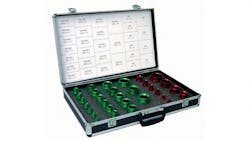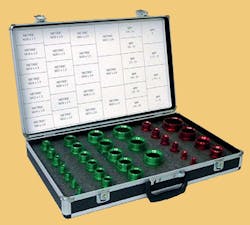International thread identification kit is used for determining male and female thread dimensions. The kit includes a carrying case and 31 dual-threaded, heat-treated aluminum gauges for quick identification of both British-Standard-Parallel-Pipe (BSPP) and metric threads. Thread-gauge sizes range from M8 x 1.0 to M52 x 2.0 for metric sizes, and from ⅛-28 BSPP to 2-11 BSPP for BSPP sizes. Kit contains a thread and port guide booklet. Optional digital calipers are also available.
Fittings Unlimited Inc., (800) 348-8467www.fittingsunlimited.com
About the Author
Leah Scully
Associate Content Producer
Leah Scully is a graduate of The College of New Jersey. She has a BS degree in Biomedical Engineering with a mechanical specialization. Leah is responsible for Hydraulics & Pneumatics’ news items and product galleries.
Sign up for our eNewsletters
Get the latest news and updates

Leaders relevant to this article:

